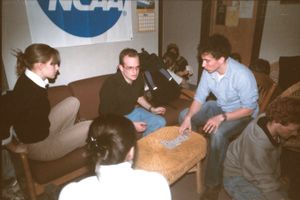| Willipedia is now back online as of 5/5/2019 |
| It has been several years since Willipedia closed. Please help get it updated! |
| Go to the Willipedia 2.0 Project to learn more. |
Bridge Club
The Bridge Club is a group of students interested in learning, teaching, and playing the card game of bridge.
Social bridge
The club's main activity consists of a regular weekly social bridge night, in which players gather to play and teach each other the game in a very causal setting, historically a common room in the Odd Quad. Players rotate in and out between hands by informal agreement, so that every player et to play with and against everyone else. Rubber bridge, the more version of the game in which the luck of the cards matters more, is played. Sometimes point are kept, sometimes not, but trash talking is just about always encouraged.
Duplicate bridge
In duplicate bridge, a number of teams each play the same sets of cards, thus removing the factor of the luck of the draw from play. This is the version of bridge played in tournaments, and bridge club held four duplicate tournaments in 2004-5, open to all players of minimal experience or greater.
History
As the game itself has fallen greatly in its popularity among the general population, especially among those younger than 60, so too has the club experienced spikes and valleys in its membership at Williams. By Spring 2002, the club was meeting in the form only of a few Odd Quadders who got together to play and teach their friends, but did not advertise meetings or have a listserver. Jason Carini '02 was the last player then to have experienced an active club, and was technically the president of the defunct organization.
Jason passed the leadership of the club to Alaya Kuntz '04, who gathered a list of the names and email addresses of known players and people interested in learning on campus. Brent Yorgey '04 created a listserver of these people and started a regular social bridge game night in the northern common room on Currier's third floor, and Jonathan Landsman later started a tradition of writing the weekly summons to bridge in humorous styles. Attendance ranged from about 4 to 8, one or two tables, each week.
2003-4 the official club leadership passed to Jonathan, who lived in Currier third floor that year and kept the meetings in the same common room. Attendance increased markedly in the fall largely due to the game's popularity among a group of students on campus to work there the previous summer, when a lot of new players, particularly '05s, were taught.

This school year two notable events in the Bridge Club's history occurred: During Winter Study '04, Matthew Spencer '05 had the idea to teach bridge as a Free University class. The class was surprisingly popular: sessions were held in the hour before the weekly social bridge night, so that at the end of class experienced players would arrive and give new players the opportunity to try what they had learned in real games. As many as a half dozen students showed for the beginning classes, and at times bridge filled both the north and south common rooms, with over 20 people playing.
At the end of Winter Study, bridge club held its first duplicate bridge tournament in recent history, using the duplicate equipment of the Williams Bridge Club of old, which Professor Morgan had stored over the years while the club was dormant. Jonathan Landsman handled the advertising to all players in the area, on and off campus. Matt Spencer handled the details of scoring and directing the tournament. It drew 12 partnerships, three of beginners taught in the Free U class. All together, 22 students and two professors played. Daniel Krass '05 and Professor Morgan won the tournament.
The spring after that winter study was the peak level of the club's popularity in recent time. Bridge nights typically had at least two tables, often more. The Boston Globe got in touch and quoted members of Williams' club in its article on the return of bridge to college campuses. At the end of the year, the club held a second duplicate tournament, notable for 24 players again, including two players from the local community, eight new players, three professors, and two high-school students.
See also
- Article "A Winning Hand" in The Boston Globe
- Article "At The Tournament Table, Learning By Doing" in The New York Times
- Ephblog post "Bridge At Williams, 2001-2005 And After"
- Bridge Club conventions, an article of information on the club's past bidding systems, as developed by past members.
- The club's alumni incaration, 8NT.